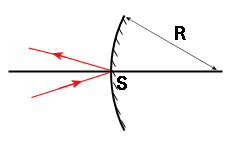Uses of Convex Mirror and its Applications
A convex mirror is a curved mirror whose shiny surface bulges outward. It is also called a diverging mirror because it spreads light rays apart when they reflect. Convex mirrors always form small, upright, and virtual images, no matter where the object is placed. These mirrors are used in many real-life applications. They are used as rear-view mirrors in vehicles to give a wide range view of the road behind. They are also used for safety and security in shops, parking areas, and at road turns. In addition, convex mirrors are used in telescopes, microscopes, and other optical instruments. This Topic is very important for class 10th , 12th and for competitive exams like JEE Mains and NEET.

Also read -
What is Convex Mirror?
A convex mirror is a spherical mirror whose reflecting surface bulges outward, i.e., it reflects light from its outer surface. It is also known as a diverging mirror because it spreads the light rays apart after reflection.
Convex mirrors always form virtual, erect, and smaller images of the objects, no matter where the object is placed in front of them.

The following are some examples of uses of convex mirror class 10 mirror applications-
- Building interiors
- Mirrors on vehicles
- magnification glass
- For the sake of security
The convex mirror always creates a virtual image of the object, and the image created by the convex mirror is always smaller than the actual object. As a result, the most prevalent applications for convex mirrors are in situations where larger things must be observed on a smaller scale. Convex mirrors are more commonly utilized inside car mirrors than concave or plane mirrors because they have a larger visual field. The following are some of the most important and common applications of uses of convex mirror.
Uses of Convex Mirror
Convex mirrors used inside the buildings-
A convex mirror is used in large workplaces, stores, and hospitals to allow people to look around the corner and avoid colliding with one another.
Convex mirrors used in vehicles-
Because they can diverge light beams and create virtual pictures, convex mirrors are commonly employed as rear-view mirrors in automobiles and transportation.

Convex mirrors used for security purposes-
Convex mirrors are often employed for security in a variety of settings. They are locations near ATMs where bank customers can check to see if someone is standing behind them.
These were some of the most prevalent applications for convex mirrors in the real world. Convex mirrors are also utilized in a variety of other applications, such as street light reflectors because they can distribute light over a larger area. They're also used to build mirrors for telescopes and ceiling domes.
Convex mirrors used in street lights-
Because it can disperse light beams across a broader area, convex mirrors are utilised as street light reflectors.
Convex mirrors used in sunglasses -
The development of a sunglass lens uses convex mirrors. The overall goal of these glasses is to reflect sunlight away from the wearer.
Convex mirrors used in telescopes -
In telescopes, convex mirrors are employed to provide point-sized views of faraway objects.
Also check-
- NCERT Exemplar Class 11th Physics Solutions
- NCERT Exemplar Class 12th Physics Solutions
- NCERT Exemplar Solutions for All Subjects
NCERT Physics Notes:
Related Topics Link,
- Concave and Convex Spherical mirrors
- Convex Mirror
- Derivation of Mirror Formula
- Difference Between Concave and Convex Mirror
- Uses of Concave Mirror
Also Read:
Frequently Asked Questions (FAQs)
The following are three applications for convex mirrors:
It also serves as a vigilance mirror
It's utilized in street lamps as a reflector.
It used as a rearview mirror in vehicles
Convex mirrors are employed in the construction of structures, as well as in the manufacture of eyewear lenses, magnifying glasses, security systems, and telescopes.
Microscopes, magnifying glasses, and eyeglasses all use convex lenses. They're also employed in cameras to provide realistic views of objects that are far away.
The person withdrawing cash can keep an eye on what is happening on behind them by strategically installing convex mirrors in an appropriate location, allowing them to respond quickly if someone suspect appears.
The drivers' eye-to-mirror distance has an impact on distance/depth perception in mirrors. Due to higher eye-to-mirror lengths than driver-side mirrors, convex passenger-side mirrors generate a greater overestimation of a following vehicle's distance (Flannagan et al., 1997).